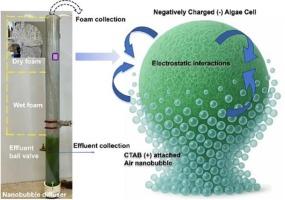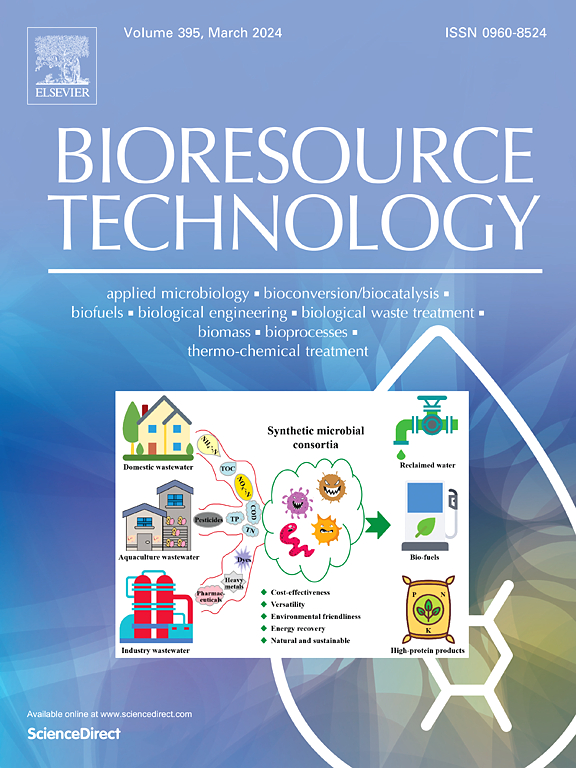Nanobubble-enabled foam fractionation to remove freshwater microalgae and microcystin
IF 9
1区 环境科学与生态学
Q1 AGRICULTURAL ENGINEERING
引用次数: 0
Abstract
Climate change and water pollution intensify algal blooms in natural lakes and reservoirs, leading to significant water quality challenges. Effectively removing excessive microalgae and algal toxins or micropollutants is essential for improving water quality, preserving aesthetic value, and protecting human health. This study evaluated the use of nanobubble-enabled foam fractionation for the removal of Microcystis aeruginosa and three microcystin congeners (MC-LR, MC-RR, and MC-YR). Foam was generated using air nanobubbles combined with surfactants—cetyltrimethylammonium bromide (CTAB), sodium dodecyl sulfate (SDS), and chitosan—to enhance foamability and stability. Among the tested surfactants, CTAB exhibited the highest foamability, yielding improved removal performance. When CTAB concentration increased from 40 to 80 mg·L−1, algal removal efficiency slightly improved from 60.0 ± 5.2 % to 69.0 ± 2.6 %, while the concentration factor declined from 4.45 to 3.37 due to enhanced frothing. Increasing salinity from 10 mM to 100 mM significantly reduced the concentration factor from 3.9 ± 0.1 to 0.9 ± 0.5, indicating that elevated ionic strength impairs foam-based separation of algal biomass. Removal of microcystins was influenced by both the presence of microalgae and surfactant conditions. MC-RR showed higher removal in the absence of microalgae (43.2 ± 1.5 % to 56.8 ± 2.0 %) compared to that (27.0 ± 5.6 % to 28.3 ± 3.3 %) when algae was present, suggesting competition during foam separation. Among the three congeners, the most hydrophobic MC-LR exhibited the highest foam affinity, with a removal efficiency of 77.4 ± 9.2 %. Test results from real lake water suggest that the complex water matrixes (e.g., salinity and dissolved organic matters) slightly affected foaming ability and reduced removal rates of target algal pollutants, especially at lower surfactant doses. These findings provide new insights into integrating nanobubble-enhanced foam fractionation into water treatment systems for mitigating harmful algal blooms (HABs) and microcystins.

纳米气泡泡沫分馏去除淡水微藻和微囊藻毒素。
气候变化和水污染加剧了天然湖泊和水库的藻华,导致严重的水质挑战。有效去除过量的微藻和藻毒素或微污染物,对改善水质、保持美学价值和保护人体健康至关重要。本研究评估了使用纳米气泡泡沫分离去除铜绿微囊藻和三种微囊藻毒素同系物(MC-LR, MC-RR, MC-YR)的效果。利用空气纳米泡与十六烷基三甲基溴化铵(CTAB)、十二烷基硫酸钠(SDS)和壳聚糖等表面活性剂结合产生泡沫,以提高泡沫的可泡性和稳定性。在所测试的表面活性剂中,CTAB具有最高的泡沫性,具有更好的去除性能。当CTAB浓度从40 ~ 80 mg·L-1增加时,除藻效率从60.0 ± 5.2 %提高到69.0 ± 2.6 %,而由于起泡增强,浓度因子从4.45下降到3.37。当盐浓度从10 mM增加到100 mM时,浓度因子从3.9 ± 0.1显著降低到0.9 ± 0.5,表明离子强度的提高会影响泡沫基浓度。微囊藻毒素的去除受微藻存在和表面活性剂条件的影响。MC-RR显示更高的去除没有微藻(43.2 ±1.5 % 56.8 ±2.0 %)比(27.0 ±5.6 % 28.3 ±3.3 %)藻类存在时,建议在泡沫分离的竞争。在三个同系物中,疏水性最强的MC-LR具有最高的泡沫亲和性,去除效率为77.4 ± 9.2 %。真实湖水的测试结果表明,复杂的水基质(如盐度和溶解的有机物)对泡沫能力略有影响,并降低了目标藻类污染物的去除率,特别是在较低的表面活性剂剂量下。这些发现为将纳米气泡增强泡沫分离整合到水处理系统中以减轻有害藻华(HABs)和微囊藻毒素提供了新的见解。
本文章由计算机程序翻译,如有差异,请以英文原文为准。
求助全文
约1分钟内获得全文
求助全文
来源期刊

Bioresource Technology
工程技术-能源与燃料
CiteScore
20.80
自引率
19.30%
发文量
2013
审稿时长
12 days
期刊介绍:
Bioresource Technology publishes original articles, review articles, case studies, and short communications covering the fundamentals, applications, and management of bioresource technology. The journal seeks to advance and disseminate knowledge across various areas related to biomass, biological waste treatment, bioenergy, biotransformations, bioresource systems analysis, and associated conversion or production technologies.
Topics include:
• Biofuels: liquid and gaseous biofuels production, modeling and economics
• Bioprocesses and bioproducts: biocatalysis and fermentations
• Biomass and feedstocks utilization: bioconversion of agro-industrial residues
• Environmental protection: biological waste treatment
• Thermochemical conversion of biomass: combustion, pyrolysis, gasification, catalysis.
 求助内容:
求助内容: 应助结果提醒方式:
应助结果提醒方式:


